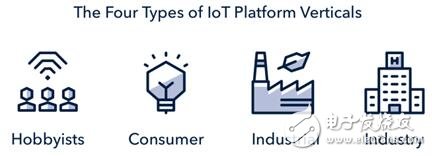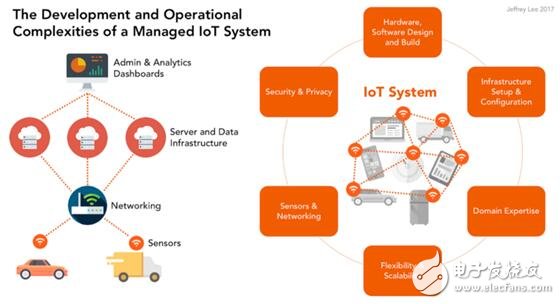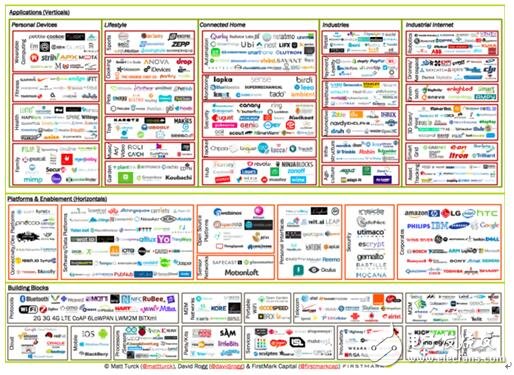Whether you are an IoT enthusiast, an experienced developer, or a senior executive, choosing the right platform is always a tricky job in the face of the dazzling IoT platform. This article is designed to filter out the complexities and provide a quick, detailed guide to your IoT platform choices. It will also provide you with information on how to evaluate the IoT platform based on your needs.
First, what is the Internet of Things platform?
In short, the IoT platform gives you the comprehensive services you need to connect your physical targets to your network. It needs to be able to support simultaneous connections of millions of devices and easily configure device-to-machine communication.
Second, the Internet of Things platform type1. End-to-end IoT platform
Fundamentally, the end-to-end IoT platform provides hardware, software, connectivity, security, and device management tools that can handle millions of concurrent device connections. It also provides all on-demand managed integrations including: OTA (Over-the-Air Technology) firmware updates, device management, cloud connectivity, mobile modems, and the ability to connect and monitor a variety of online devices.
Platform example: ParTIcle
2. Connection management platform
These platforms offer low-power and low-cost connectivity management solutions through Wi-Fi and cellular networking technologies. They cover features such as hardware connectivity, cellular networking, and data routing.
Platform examples: Mulesoft, Hologram, Sigfox
3. Internet of Things cloud platform
The cloud platform is designed to help you get rid of the complexity of your own network stack and monitor and track the simultaneous connections of millions of devices by providing back-end services (and other services).
Platform example: Google Cloud IoT, Salesforce Cloud IoT
4. Data platform
Although each IoT platform has its own way of processing data. But they all combine the tools needed to manage and visualize device data routing and data analysis.
Platform examples: Clearblade, Azure, and ThingSpeak
Third, the platform of the Internet of Things is verticalOf course, categorizing various IoT platforms in a single category is a simple introduction. Since each platform tends to provide more solutions, based on simple classification, we need to check the content they provide and the objects they serve.

Fan
Prototype solution
Development kit
DIY solution
2. Consumer electronics
public facilities
Home automation
Wearable product
Various devices related to Alexa (Amazon's voice assistant)
3. Industrial Internet of Things (IIoT) solutions
Warehousing applications for various smart factories
Predictive and remote maintenance
Industrial safety system
Asset tracking and intelligent logistics
Energy optimization
Transportation monitoring
Connected logistics
4. Industrial drive
agriculture
health care
transport
Smart city
energy
Fourth, what should be paid attention to when considering the platform
When considering these platforms, you should pay attention to the following aspects according to your own plan:
Connectivity
What is the network coverage of the supplier? Does it meet your company's current and future initiatives?
2. Connection method
What type of connection do you need? Do you need a Wi-Fi or cellular network solution for your IoT product? You need to assess these needs and understand how suppliers are fulfilling these needs.
3. Market life
How long has the IoT platform been operating? As the entire IoT field is relatively new and fast-developing, an IoT platform that has been providing services for more than 4 years will be an ideal choice.
4. Service type
How does the IoT platform describe and market itself? Some are purely connected platforms, while others are solutions that provide hardware, software, and end-to-end connectivity. You need to assess your business needs. How will your needs change over time?
5. Geographic coverage
Do they provide global support? Can the IoT platform cover the areas covered by your business?
6. Data package
Does the supplier provide a reasonable data plan? You need to be able to pause or terminate the data service at any time and be able to know the amount of data used.
7. Security / Privacy
Check how they have dealt with security and privacy issues in the past, including the corresponding security content. You need to assess how the platform addresses security issues and how to make it simple for you.
8. Managed integration / API access
How do vendors provide all the complex functions required for the Internet of Things (eg cellular network modem, carrier/SIM card, device diagnostics, firmware update, cloud connectivity, security, application layer, RTOS (Real TIme OperaTIng System) )) integrated into a single package to make your team ready to use?
9. Data access
How will you integrate enterprise backends with current cloud services through this IoT platform? How will you get and process the relevant data? Does its service meet your needs?
10. Domain Expert / Engineering Services / Partners
Because the deployment of the Internet of Things is relatively complex, you often need a partner who can assist you with the entire product development process. So can the IoT platform help you achieve these needs?
11. The Internet of Things ecosystem
Please take the time to learn and understand the relationship between the various services offered by the IoT platform. This will help you understand how their service builds the product. Of course, you can also contact your sales representative directly.
12. Roadmap for the Internet of Things
The IoT platform will gradually expand the content of its services. Therefore, you need to consider whether the roadmap for the IoT platform meets the needs of your organization. Are their extensions in connectivity, data, and hardware beneficial to you?
13. Hardware
Can the vendor offer a variety of off-the-shelf applications, developer kits or starter kits for your specific use case? You may need to do some customization, but in order to save a lot of time and effort, you should not start from scratch.
14. Hardware Agnosticism
Hardware agnosticism means: "We just focus on processing software, which means that hardware is transparent and unknowable to us." So we should not be limited by hardware.
15. Equipment Management
How can vendors allow you to monitor, segment and manage IoT devices on the spot?
16. OTA firmware update
How does the vendor allow you to remotely send updates and bug fixes to your device? Is the process simple or responsible? (Of course, you definitely want a simple solution).
V. List of Internet of Things platformsNow that you understand the types of IoT platforms, industry verticals, and areas that should be noted, let's take a look at a brief list to find a platform that truly meets your needs.

The picture above is a “panorama†with more than 450 IoT services. If you don't have time to look at it, please “step†to the brief list below.
Six, a brief listParTIcle - Particle is an enterprise IoT platform that provides all the services needed to build an IoT product from device to cloud.
Salesforce IoT - Maximize your business with IoT cloud services.
Microsoft IoT Azure - Improve your operational efficiency and profitability with factory-proven solutions with pre-configured connectivity.
Artik Cloud - The ARTIK IoT platform supports open data exchange for the Internet of Things.
Google Cloud IoT Platform - Provides secure connectivity, easy management and integration of IoT data capture.
IBM Watson IoT - IBM's new Watson Internet of Things (IoT) is a cognitive system that learns from the physical world and integrates intelligence into the physical world.
ThingWorx - A fast solution for industrial companies that combines physical value with digital.
Xively Platform – This enterprise-class IoT platform can help you accelerate the connection between products or services.
ThingSpeak Platform - ThingSpeak is an open IoT platform with MATLAB analysis capabilities.
The Carriots Platform – is a service designed specifically for IoT projects. It collects, stores, and builds powerful applications from different objects.
C3 IoT – is a complete platform for rapid development, big data operations, predictive analytics, AI and IoT software applications.
High voltage
Resistor dividers (RFD Series)
are suited for all the fields of high voltage and small signal multiply. Such as
Such as High voltage power
supply, Medical electronical devices,
Audiophile speakers, Audio systems, Smoke sensors, Infrared detectors, Radiation detectors, Special gas detectors
High Voltage Polyester Capacitor,High Voltage Divider,Flat High Voltage Divider,High Voltage Resistor Dividers,High Power Resistor
XIAN STATE IMPORT & EXPORT CORP. , https://www.shvcomponents.com